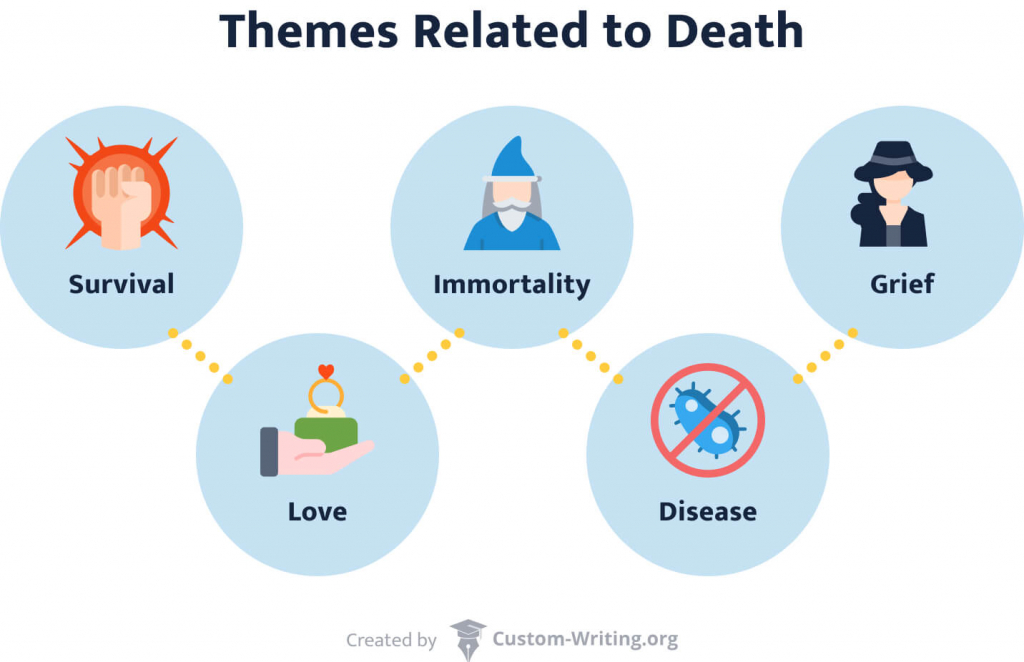The themes about death and mortality are both haunting and captivating. Confronting the vast emptiness of death, people find themselves searching for answers to the meaning of life. Skelton (2003) suggests that, like science, literature seeks to understand life and death, offering emotional and existential meaning to our experience of the human condition.
This article, developed by Custom-Writing.org experts, explores the theme of death in literature. It contains:
- An examination of how death is portrayed in English, American, children’s, and contemporary literary works.
- The related themes like survival, disease, grief, and immortality.
- Essay topics on death in literature assignments.
- Examples of the theme of death in literary works such as Hamlet, A Good Man is Hard to Find, and A Rose for Emily.
Each subsection contains relevant quotes illustrating how death themes shape each work’s plot and message.
💀 Significance of Death in Literature
Why is it important to write about death? Well, there are many reasons behind people’s curiosity about the said phenomenon. Death is unavoidable and intangible, something that can’t be seen or explained. One of literature’s central tasks is to give structure and meaning to things that are otherwise hard to perceive.
When it comes to death, literature has several functions:
- It helps to deal with grief and death anxiety;
- It gives meaning to life and death;
- It makes sense of the phenomenon of death.

It’s also important to note that death as a theme exists separately from biological or physical death, as writers mainly focus on its spiritual and supernatural aspects.
🔮 Theme of Death in Literature: How Is It Presented?
Literary works make readers experience things and rethink the preexisting ideas of the world around them. However, these experiences are subjective. So, unsurprisingly, in various literary works, death is portrayed differently.
In every literary genre, the existence of death serves a different purpose:
- In horror stories, it evokes fear or wonder.
- In mystery novels, it creates a sense of curiosity and advances the plot.
- In a tragedy, it usually leads to a moment of catharsis and provides closure.
The range of attitudes towards death also differs depending on the culture and the time period when the work was written.
Theme of Death in English Literature
Preoccupation with religion was the most notable feature of the Middle Ages. The church held unchallenged dominion over every aspect of people’s life. It’s not surprising that the ideas of hell and heaven were more certain than anything in the visible world.
During the Renaissance, people still held strong religious ideas. However, with the development of science, the representation of death in works of art became more realistic. Death became equivalent to annihilation.
Shakespeare’s Hamlet is an example of a tragedy that conveys that message. “The rest is silence” are the last words of Prince Hamlet. The phrase indicates that there’s no afterlife: an idea fairly different from what the majority believed around that time.
Death in Victorian Literature
Similar to the medieval era, the mortality rate during the Victorian time was very high, so the death theme in literature continued to stay relevant and popular. Despite the 19th century being the era of secularization, it was also a period of sustained religious revival. That’s why the Victorian era is often called a golden age of supernatural stories.
- A good example of a 19th-century novel that deals with the theme of death is Emily Bronte’s Wuthering Heights. As many as 11 characters die throughout the story. In the case of Heathcliff and Catherine, death is the only means that can unite them.
- Charles Dickens is another famous figure whose novels cover the topic of death. In his sentimental novels, however, he focuses on the aspect of mourning rather than death’s freeing quality.
Death in American Literature
Literary critics agree that death is one of the most prominent themes in American literature. Many famous authors have devoted their works to this particular topic:
- In Herman Melville’s fiction, characters die regardless of age, social status, or moral characteristics. That shows how inevitable death is and how unpredictable life can be.
- Nathaniel Hawthorne worked in the Gothic genre, which includes supernatural elements, responds to social anxieties, and explores the topic of death.
- When it comes to poetry, Emily Dickinson is one of the first names that come to mind. In many of her poems, she touches upon the topics of death and immortality.
- Another famous figure worth mentioning is Edgar Allan Poe. His name is closely associated with the horror genre. An excellent example of a literary work where death is one of the central themes is Poe’s short story The Cask of Amontillado.
- The topic of death is also characteristic of African American literature. It often focuses on the arc of mourning, such as in Toni Morrison’s Beloved.
Death in Children’s Literature
Although it may seem bizarre now to most people, death used to be one of the major themes in juvenile literature. Children’s books often mirror society and its complexity in a particular epoch. By introducing concepts such as death, the stories prepare children for the world’s harsh realities.
The concept of death has also served as a major plot device. For example, it was often used as a punishment for antagonists. Such stories stressed the importance of salvation and the precariousness of life. They also conveyed a moral message that reflected society’s values. As child mortality rates have decreased with time, the death theme has become less reoccurring in the kids’ literature.
Death Theme in Contemporary Literature
The contemporary view of death is far from that in ancient tragedies or Renaissance fiction. In the past, the death theme was often used as a plot device to provide closure or catharsis. Contemporary fiction usually presents a more realistic depiction. Death no longer serves as a moment of closure. Instead, it can work as an opening of a new story.
💡 Death in Literature: Related Themes
Death is undoubtedly one of the most popular topics in literature. Themes such as love, survival, disease, immortality, and grief are almost always portrayed in conjunction with death and are closely related to it.

Theme of Survival in Literature
Survival stories usually focus on characters that try to avoid death at any cost. They often find themselves in a hostile environment, out in nature, or in the midst of war. These stories portray people who are forced to fight for their lives and often show how far they can go to accomplish this goal.
The Road by Cormac McCarthy is an excellent example of survival fiction. It features a father and a son who travel through a post-apocalyptic world. The novel can be interpreted as a modern take on Homer’s The Odyssey.
Love and Death in Literature
It might be true that the fastest way to die in literature is to fall in love. Young lovers tragically dying at the end is a common trope that goes back to courtly literature. In its context, love is always unattainable. As a result, archetypes such as Romeo and Juliet or Tristian and Isolde gained popularity outside the genre.
Immortality in Literature
Immortality is a theme that has been very powerful within the literary tradition in almost every country. On the one hand, it can be presented as the end goal of a character who strives to gain eternal life. On the other hand, it’s usually seen as something that isn’t worth pursuing.
One example is The Picture of Dorian Gray by Oscar Wilde. It shows how the desire for eternal youth can lead to a person’s downfall.
Death by Disease in Literature
Deadly diseases can often be seen in literature written during epidemics. Diseases such as the plague are sometimes used as plot devices. They can also serve as a divine punishment, add to the mystery, and evoke the feeling of dread in the readers.
The Masque of the Red Death by Edgar Allan Poe is an example of a story where a disease acts as an agent of death.
Theme of Grief in Literature
Grief is arguably life’s greatest source of distress. It is closely related to death, especially that of loved ones. Literary works that focus on the concept of mourning help people to face their worst fears and get through the loss of their loved ones.
Putting feelings into words makes it easier to cope with grief and gives meaning to the lives of the ones who passed. One good example of mourning literature is the novel Beloved by the American author Toni Morrison.
✍️ Death Essay Topics
Death is a widely discussed topic not only in literature but also in mythology, psychology, philosophy, medicine, and many other studies. If you need to write an essay on death, here are some examples of topics:
- The many faces of death.
- Nietzsche and the death of God.
- Burial practices of Native Americans.
- Death as a psychological phenomenon.
- Chinese philosophy on dealing with grief.
- Death in Ancient Greek and Roman cultures.
- Is the death penalty a fair punishment?
- Funeral customs and cultural implications of death.
- Why is the discussion about end-of-life care meaningful?
- Ways to portray death in the traditional and modern context.
Death in Literature Essay Topics
From ancient Greek literature to modern fiction, the topic of death stays relevant. It’s analyzed and talked about in many essays and research papers. Here’s a list of literature essay topics that may come in handy:
- Death in Gothic literature.
- Sylvia Plath and the poetics of death.
- The nature of death in Emily Dickinson’s poetry.
- Death in Camus’ The Outsider.
- Suicide in modern Japanese literature.
- Dance of the Dead in Medieval literature.
- Symbolism of clock in Poe’s The Masque of the Red Death.
- The poetry of mourning and its cultural significance.
- The personification of death in American literature.
- How do literary works shape people’s perception of death?
Theme of Death in Hamlet Essay Topics
Shakespeare’s Hamlet is probably the most famous literary work exploring death and its implications. Throughout the play, the phenomenon of death manifests itself in various forms. Here are some essay topics related to the famous tragedy:
- The idea of suicide in Hamlet.
- The meaning of Ophelia’s death.
- Death, disease, and decay in Hamlet.
- Murder as the ultimate goal in Hamlet.
- Death and the questioning of human existence in Hamlet.
- Hamlet and his obsession with death.
- How does grief affect Hamlet’s development as the character?
- How does death manifest itself in Shakespeare’s Hamlet?
- How does the change in the point of view on death affect Hamlet’s character?
- “Death, the undiscovere’d country, from whose bourn no traveler returns.” The importance of the quotation on the understanding of Hamlet.
📚 Theme of Death in Literature: Examples
Death has always been a topic many authors used to elicit an emotional response from the reader. In fiction, poetry, and theater death theme gives way to other topics ranging from love to madness. This section will introduce some literary works that have death as one of their central themes.
Theme of Death in Hamlet
Hamlet is arguably the most influential tragedy written by William Shakespeare. The theme of death in the play is tightly connected to those of grief, revenge, suicide, and murder. The author also incorporates some supernatural elements, such as the ghost of Hamlet’s father, to convey the sense of mystery. The ghost itself symbolizes the disruption to the preexisting social order of the time.
Hamlet’s most straightforward consideration of death happens in Act 4, Scene 3. In that scene, the young prince ironically describes the life-cycle of human existence. He interprets it this way: we eat in life, and later we are eaten in death. In Act 5, the play once again returns to the question of human existence. Hamlet ponders the futility of the human condition and the inevitability of death. Another encounter with death is through the character of Ophelia, who might have taken her own life.
The concept of suicide is also present throughout the play. It’s especially prominent in Hamlet’s famous soliloquies. However, Hamlet himself never attempts to take his own life. The whole plot of Shakespeare’s play is based on the idea of death; Hamlet becomes obsessed with revenge, but by doing so, he also becomes the agent of death.
Want to know more? Check out our article on themes in Hamlet.
Hamlet Quotes about Death
In Shakespeare’s Hamlet, death is the driving force behind the major events of the play. It becomes the cause and the consequence of revenge. Here are some quotes from the tragedy that are related to death:
To die,—to sleep,—
Hamlet, Hamlet, Act 3, Scene 1
No more; and by a sleep to say we end
The heartache, and the thousand natural shocks
That flesh is heir to,—’tis a consummation
Devoutly to be wish’d.
To be, or not to be: that is the question.
Hamlet, Hamlet, Act 3, Scene 1
Thou know’st ‘tis common; all that lives must die,
Hamlet, Queen Gertrude, Act 1, Scene 2
Passing through nature to eternity.
Death Theme in A Good Man Is Hard to Find
Flannery O’Connor’s A Good Man Is Hard to Find presents the writer’s view on the outcome of life. It exhibits a deep religious insight through the use of the theme of death.
The Misfit is one way O’Connor portrays death. When the Misfit kills the grandmother, the readers are again reminded of mortality and its significance. However, the murder of the grandmother is foreshadowed from the very beginning of the story. The description of her dress, the passing away of the family, and the conversation with Misfit allude to her death.
The woman’s anxiety about death is what eventually leads her and her family to be the victims of murder. A Good Man is Hard to Find features a confrontation between a grandmother who personifies a superficial sense of goodness and a criminal that embodies evil. In turn, however, that said an evil man is the one who causes the older woman to see herself for what she is: a sinner. According to Christian values, death is life’s most precious gift. For that reason, grandmother’s desire to avoid it seems almost comical.
You’re welcome to check out our article on themes in A Good Man is Hard to Find where you can find more interesting info.
A Good Man Is Hard to Find: Quotes about Death
Here are some of the best death-related quotes from Flanner O’Conner’s short story A Good Man is Hard to Find:
Her collars and cuffs were white organdy trimmed with lace and at her neckline she had pinned a purple spray of cloth violets containing a sachet. In case of an accident, anyone seeing her dead on the highway would know at once that she was a lady.
A Good Man, Narrator
“She would of been a good woman,” The Misfit said, “if it had been somebody
A Good Man, The Misfit
there to shoot her every minute of her life.”
It was a head-doctor at the penitentiary said what I had done was kill my daddy but I known that for a lie. My daddy died in nineteen ought nineteen of the epidemic flu and I never had a thing to do with it.
A Good Man, The Misfit
Death in A Rose for Emily
The short story A Rose for Emily, written by William Faulkner, is an example of Southern Gothic literature, so death is naturally one of the story’s central themes. It presents itself in various forms throughout the plot.
In A Rose for Emily, Faulkner reflects the struggle that comes with maintaining tradition in the face of radical change. Emily herself may personify old values and practices that are getting replaced. Emily lives in her own world, which is a timeless vacuum.
Death dominates the story from the very beginning to end. Emily’s whole life has been haunted by death and loss. First, her father passes away, then her lover Homer. Emily tries to exert power over death by denying its existence in the first place. For instance, when Homer dies, Emily refuses to admit the fact of his death, even though she’s the one who inflicts it on him. Emily’s attempt at having a grotesque marriage with Homer’s dead body reveals her disturbing desire to fuse life and death. Nevertheless, it ends with death’s triumph.
Death Quotes in A Rose for Emily
The power of death is masterfully reflected in William Faulkner’s short story A Rose for Emily. Here are some quotes that demonstrate it:
So the next day we all said, “She will kill herself”; and we said it would be the best thing.
A Rose for Emily, Narrator
She died in one of the downstairs rooms, in a heavy walnut bed with a curtain, her gray head propped on a pillow yellow and moldy with age and lack of sunlight.
A Rose for Emily, Narrator
When Miss Emily Grierson died, our whole town went to her funeral: the men through a sort of respectful affection for a fallen monument, the women mostly out of curiosity to see the inside of her house, which no one save an old manservant— a combined gardener and cook— had seen in at least ten years.
A Rose for Emily, Narrator
We hope you enjoyed reading through our article and learned something new! Don’t hesitate to share it with your friends. Good luck exploring various themes in literature.
❓ Theme of Death in Literature
What Is the Theme of Because I Couldn’t Stop for Death?
Because I Couldn’t Stop for Death is a lyrical poem written by Emily Dickinson. The most apparent themes of the poem are mortality and death. It’s an exploration of the inevitability of death and the uncertainties surrounding the dying process.
What Is the Theme of The Masque of The Red Death?
The short story The Masque of the Red Death, written by Edgar Allan Poe, is about the inevitability of death. Wealth and social status ultimately don’t matter: death can easily take anyone’s life anytime.
What Is the Theme of Death Be Not Proud?
The theme of John Donne’s poem Death Be Not Proud is that death can’t corrupt the soul. The poet sees death not as a victor that claims his life but as something that frees his soul from his body.
Is Death a Theme in Poetry?
Death is a major topic in many literary works, including poetry. Works of poets such as Sylvia Plath, Emily Dickinson, Edgar Allan Poe, Robert Frost, etc., only prove that. The authors consistently write about death and its various manifestations.
🔍 References
- Death and Dying in Literature: Cambridge University Press & Assessment
- Why Death Is so Important in YA Fiction: The Guardian
- Death and Literature: Different Approaches, from Simplicity to Obscurity: Redalyc
- Death in Literature: Cambridge Scholars Publishing
- Can Books Ease the Pain of Grief?: BBC
- The Meaning of Death in Shakespeare’s Hamlet: Harvard University
- A Summary and Analysis of William Faulkner’s “A Rose for Emily”: Encyclopedia
- Death, Be Not Proud: Encyclopedia Britannica
- Water and Liquid in Toni Morrison’s Beloved: Dickinson College
- Why We Write about Grief: The New York Times
- Because I Could Not Stop for Death: The City University of New York
- The Masque of the Red Death: California State University Dominguez Hills











